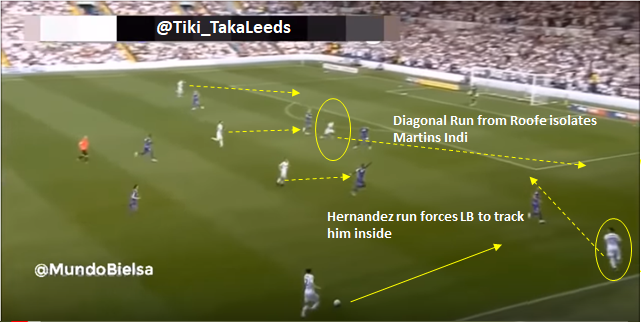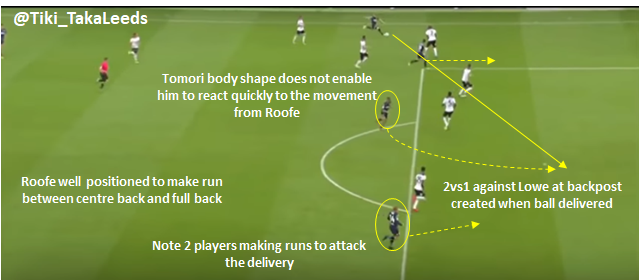Marcelo Bielsa expressed his feelings post-match that Frank Lampard had “a good taste for attacking football” however over the course of 90 minutes, the rookie Derby coach received a schooling in ruthless, structured and penetrative attacking football from his Argentine counterpart. Lampard set his Derby side up in a 4-3-3 shape looking to play expansive, possession-based football but the lack of structural security when in possession was a vulnerability exposed by Leeds United’s vertical football.
In many ways it was kamikaze football from Derby, with their naivety affording Samu Saiz the freedom of Pride Park in the space between the defensive and midfield lines where the Spanish midfield maestro is most effective. On several occasions the entirety of Derby’s central midfield committed to running beyond the ball. The addition of Bielsa’s much fabled high press into this mix was tantamount to Derby playing a game of Russian Roulette and it would be safe to conclude that chance wasn’t in their favour on Saturday. The opening three goals for Leeds came from situations where Derby would have expected to have been enjoying secure possession. The ability of Leeds to hunt in packs, identify pressing triggers, recover the ball and play forward quickly to break the lines.
The dynamic of Leeds in midfield, with Kalvin Phillips playing deep as the destroyer, Mateusz Klich playing from box to box as the engine and Saiz playing as the technician (with increased intensity off the ball), looks much more effective and much more capable of dealing with the varied range of playing styles seen in the Championship. The combination of these roles in midfield (the destroyer, the engine and the technician) is an essential ingredient for success, even if the recipe must be varied slightly to account for the traits of the opposition.
It was no surprise that Lampard elected to change his shape to match Bielsa’s 4-1-4-1 and introduce Bradley Johnson to attempt to mark Saiz out of the game at half time. Although this switch was effective in limiting the instances Saiz was able to get on the ball between the lines, his ability to manipulate the ball in tight areas enabled him to contribute to the attacking play as the following example, where the Spaniard got on the ball and created space on the edge of the penalty area, illustrates:


This example also demonstrates one other notable feature of Bielsa’s Leeds United so far, being the willingness to commit bodies forward into the penalty area when attacking. It is worth pointing out that in this instance, there is a 3vs2 situation at the far post and within this scenario Fikayo Tomori being overloaded 2vs1, with both Roofe and Hernandez in proximity. One would have expected Richard Keogh to assist his young defensive partner with greater authority, however, the explosive movement of Gianni Alioski away from goal saw the Derby Captain follow his runner and leave a gaping space directly in front of goal. This is one of several instances in both games so far of opponents being drawn to the ball or movement towards the ball, leaving critical expanses of space unguarded behind them.
Interestingly, the one game where Leeds managed to perform the action of pushing the full backs into the opposition box with any real kind of consistency last season was the 5-0 home victory over Burton Albion. During his press conference after the game, the Argentine referenced this as being an action that he expects his players to undertake naturally:
“When the offensive action is from the left Pablo and Ayling go to the box and when the offensive action is on the right, Alioski and Douglas go to the box.”
As per the Stoke game, the contribution of the Leeds No.7, Kemar Roofe, was again magnificent in setting the tone for Leeds defending from the front. Intelligent movement, awareness of his surroundings and a killer instinct saw Roofe deservedly bag a brace in this fixture and it was clear that Bielsa appreciated the contribution from his striker:
“It’s always important when a player scores goals. In the last game he worked more than today and in the last game he made the offensive actions of his teammates easier.”
Doubts have previously been expressed regarding Roofe’s capability to lead the line on his own, however, two consecutive man of the match performances illustrate that intelligent positioning, movement and link play can more than make up for the lack of presence one would ordinarily expect from a more conventional target man leading the line for a Championship side.
In the build-up, the striker has frequently made diagonal movements that create uncertainty between the two centre backs and full backs which have ultimately lead to instability in the back four and opened space for teammates. It is particularly interesting that most of these movements are across and in behind the defensive line, when under previous coaches it was apparent that Roofe had been instructed to drop deep to receive the ball or indeed played off the sides, which inhibited his goal threat to a certain extent. Although these movements may not seem to take Roofe towards goal in the first phase, they position him closer to goal in the second phase, where his sharp movement and goal poaching instinct can come to the fore.


When Leeds have looked to cross the ball into the box, Roofe has also taken up intelligent positions in relation to the opposition defenders and identified the space where he is likely to be afforded the best opportunity of scoring to run into:


In addition to the movement from Roofe, it is noticeable that Bielsa is looking to have at least one other player positioned in proximity to make runs into the box when the ball is out wide. Should the ball miss the first runner, or be flicked on, another player is moving in anticipation of a chance coming their way, which is considerably more adventurous than some of the attacking endeavours of last season.
There is a growing sense of anticipation at Elland Road and the fact that this performance from Leeds United built upon all of the solid foundations and good footballing habits seen in the opening game was particularly promising, especially when the appalling run of form on the road since Boxing Day is taken into account.
The next League fixture against Rotherham represents an excellent chance for Leeds United to continue to build momentum. This may appear the most straightforward fixture of the season so far given Stoke and Derby have already been overcome but following a chastening 5-1 defeat away to Brentford on the opening day, it is likely that the visitors from South Yorkshire will set up in a bid to not give anything away at Elland Road.
Encountering a low defensive block, with limited space between the lines and limited opportunities to catch the opponent out of balance in transition may require a slightly different approach and variation in patterns to those seen in the opening two games and it will be intriguing to see how Bielsa’s Leeds attempt to overcome this.